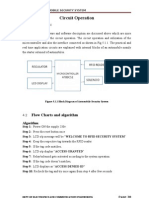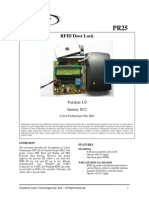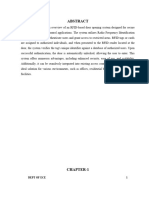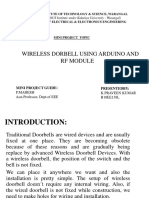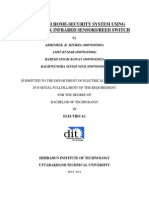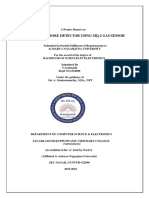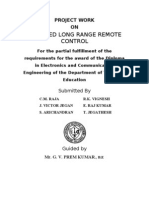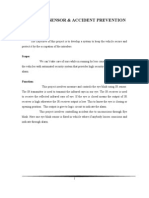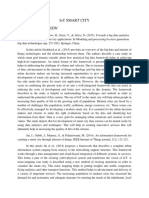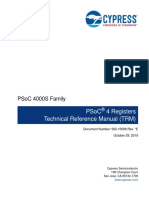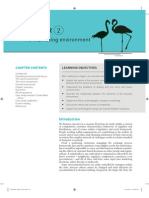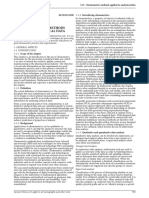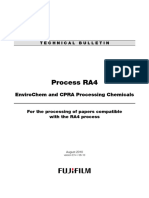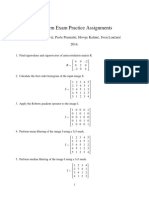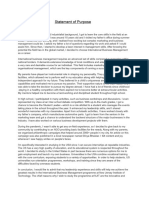Rfid Based Security System With Password & Door Mechanism
Rfid Based Security System With Password & Door Mechanism
Uploaded by
Vipul GargCopyright:
Available Formats
Rfid Based Security System With Password & Door Mechanism
Rfid Based Security System With Password & Door Mechanism
Uploaded by
Vipul GargOriginal Title
Copyright
Available Formats
Share this document
Did you find this document useful?
Is this content inappropriate?
Copyright:
Available Formats
Rfid Based Security System With Password & Door Mechanism
Rfid Based Security System With Password & Door Mechanism
Uploaded by
Vipul GargCopyright:
Available Formats
RFID BASED SECURITY SYSTEM WITH PASSWORD & DOOR MECHANISM
A Project Report submitted in partial fulfillment of the requirement for the award of the degree of
BACHELOR OF ENGINEERING
in
ELECTRONICS AND COMMUNICATION ENGINEERING
Submitted by:
VIPUL GARG
RO LL NO. ECE-228-2K7
Guided by:
Mr. DEVENDER SAINI
LECTURER
VARUN JOSHI
RO LL NO. ECE-219-2K7
VINAY KUMAR
RO LL NO. ECE-225-2K7
VISHAL AGGARWAL
RO LL NO. ECE-229-2K7
DEPARTMENT OF ELECTRONICS AND COMMUNICATION ENGINEERING GURGAON INSTITUTE OF TECHNOLOGY & MANAGEMENT GURGAON, HARYANA Affiliated to M. D. University, Rohtak, HARYANA May 2011
Acknowledgement
It gives me great pleasure & satisfaction to present major project report entitled RFiD Based Security System with Password & Door Mechanism . The completion of any task is not only the reward to the person actively involved in accomplishing it, but also the person involved in inspiring & guiding. I am highly indebted to my supervisor Mr. Devender Saini for his invaluable support and guidance throughout the work. I extend my heartful thanks to Dr. Ashok Kumar Raghava, Director Gurgaon Institute of Technology and Management (GITM), Gurgaon for providing this opportunity to carry out the project. I extend my heartful thanks to Associate Professor, Alok K Kushwaha, HOD of Electronics and Communication Engineering Deptt. for his support without which the work would have never been realized. Last but not the least; I would like to thank all friends who directly or indirectly helped me in completion of work.
Students Name ---- Roll. No---Vipul Garg Vinay Kumar Varun Jos hi Vishal Agga rwal (07-ECE-228) (07-ECE-225) (07-ECE-219) (07-ECE-229)
DECLARATION
We hereby certify that the major project entitled RFID BASED SECURITY SYSTEM WITH PASSWORD & DOOR MECHANISM, by Vipul Garg (07-ECE-228), Varun Joshi (07ECE-219), Vishal Aggarwal (07-ECE-229), Vinay Kumar (07-ECE-225) in partial fulfillment of requirements for the award of degree of B.Tech. (Electronics and Communication Engineering) submitted in the Department of Electronics and Communication Engineering at GURGAON INSTITUTE OF TECHONOLOGY AND MANAGEMENT, GURGAON under Maharshi Dayanand Unive rsity Rohtak is an authentic record of our own work carried out under the supe rvision of Mr. Devender Saini, Lecturer, Electronics & Communication Deptt. The matter presented has not been submitted by me in any other University / Institute for the award of B.Tech. Degree.
Varun Joshi
Student Name (07-ECE-219) (univ. roll no.)
Vinay Kumar
Student Name (07-ECE-225) (univ. roll no.)
Vipul Garg
Student Name (07-ECE-228) (univ. roll no.)
Vishal Aggarwal
Student Name (07-ECE-229) (univ. roll no.)
This is to certify that the above statement made by the candidate is correct to the best of my knowledge
Guides Name: Mr. Devender Saini Guides Designation: Lecturer
Project Coordinator: Mr. Bijender Kr.
HOD (ECE) Prof. Alok K. Kushwaha
CONTENTS
Acknowledgement Declaration Introduction Block Diagram Relay Circuit Components Used Working of Circuit RFID EAS Comparison of RFID With Bar-Coding Chip less RFID Overview of EAS Technology Overview of RFID Technology Program Code
ii iii 1 3 4 6 7 14 22 24 28 30
33 36
RFiD BASED SECURITY SYSTEM WITH DOOR
INTRODUCTION
This project aimed to develop a wireless system to detect and allow only the authorized persons. The system was based on Radio Frequency Identification (RFID) technology and consists of a passive RFID tag. The passive micro transponder tag collects power from the 125 KHz magnetic field generated by the base station, gathers information about the Tag ID and sends this information to the base station. The base station receives, decodes and checks the information available in its Database and Manchester code was used to send that information. The system performed as desired with a 10cm diameter antenna attached to the transponder. The Base Station is built by using the Popular 8051 family Microcontroller. It gets the tag ID and if the tag ID is stored in its memory then the microcontroller will allow the person. RFID Reader Module, are also called as interrogators. They convert radio waves returned from the RFID tag into a form that can be passed on to Controllers, which can make use of it. RFID tags and readers have to be tuned to the same frequency in order
Page 1
RFiD BASED SECURITY SYSTEM WITH DOOR
to communicate. RFID systems use many different frequencies, but the most common and widely used Reader frequency is 125 KHz. If the code is a match, then we authorized or unauthorized the card with predefined password. If the person is authorized then door is open and if the person is un-authorized then door is close. Administrator authorize or un-authorized the card as per their rules. We use this concept in paid gym, paid class room or any paid centre.
Page 2
RFiD BASED SECURITY SYSTEM WITH DOOR
BLOCK DIAGRAM
Figure 1: Block Diagram showing the Working
Page 3
RFiD BASED SECURITY SYSTEM WITH DOOR
THE RELAY CIRCUIT
Three relay based circuit for the door open logic. Here in this project we use three relay for any type of door open. IN this project we use two relay for door open and one relay for
controlling the two relays. As the signal from controller is connected to opto-coupler. Optocoupler connect first relay via transistor and, other two relay work as H bridge logic. Switch connected to first relay is of the door open and close switch
Page 4
RFiD BASED SECURITY SYSTEM WITH DOOR
Figure 2: The Circuit Diagram
Page 5
RFiD BASED SECURITY SYSTEM WITH DOOR
COMPONENTS USED
Step down transformer 220 volt ac to 9-0-9 ac Diode IN 4007 (2) Capacitor 1000mfd (2), 27pf (2), 10mfd (1) IC 7805 (1) 89S52 (8051 MICRO-CONTROLLER) RF Reader (125 kHz) serial interface LCD 2by 16 (alphanumeric LCD) Push to on switch (9) Resistor 470 ohm (1), 10k (1), 4k7(1). Variable resistor 4.7k oh (1) L.E.D (1) CD Loader (for door open) (1) Crystal Oscillator (12 MHz) (1) P.C.B RF CARD
Page 6
RFiD BASED SECURITY SYSTEM WITH DOOR
WORKING OF THE CIRCUIT
In this project we use one 5 volt regulated power supply to convert the 220 volt ac in to 5 volt dc with the help of the 5 volt regulator circuit. First OF all we step down the 220 volt ac into 6 volt ac with the help of step down transformer. Step down transformer step down the voltage from 220 volt ac to 9 volt ac. This ac is further converted into the dc voltage with the help of the full wave rectifier circuit
Figure 3: Circuit Showing the Power Supply
Output of the diode is pulsating dc. So to convert the pulsating dc into smooth dc we use electrolytic capacitor. Electrolytic capacitor converts the pulsating dc into smooth dc. This DC is further
Page 7
RFiD BASED SECURITY SYSTEM WITH DOOR
regulated by the IC 7805 regulator. IC 7805 regulator provide a regulated 5 volt dc to the microcontroller circuit and LCD circuit. Pin no 40 of the controller is connected to the positive supply. Pin no 20 is connected to the ground. Pin no 9 is connected to external resistor capacitor to provide an automatic reset option when power is on.
RESET CIRCUITRY:
Pin no 9 of the controller is connected to the reset circuit. On the circuit we connect one resistor and capacitor circuit to provide a reset option when power is on As soon as you give the power supply the 8051 doesnt start. You need to restart for the microcontroller to start. Restarting the microcontroller is nothing but giving a Logic 1 to the reset pin at least for the 2 clock pulses. So it is good to go for a small circuit which can provide the 2 clock pulses as soon as the
microcontroller is powered.
Page 8
RFiD BASED SECURITY SYSTEM WITH DOOR
This is not a big circuit we are just using a capacitor to charge the microcontroller and again discharging via resistor.
Figure 4: Reset Circuit
CRYSTALS:
Pin no 18 and 19 is connected to external crystal oscillator to provide a clock to the circuit. Crystals provide the synchronization of the internal function and to the peripherals. Whenever ever we are using crystals we need
Page 9
RFiD BASED SECURITY SYSTEM WITH DOOR
to put the capacitor behind it to make it free from noises. It is good to go for a 33pf capacitor.
Figure 5: The Crystal Oscillator
We can also use resonators instead of costly crystal which are low cost and external capacitor can be avoided. But the frequency of the resonators varies a lot. And it is strictly not advised when used for communications projects.
The speed with which a microcontroller executes instructions is determined by what is known as the crystal speed. A crystal is a component connected externally to the microcontroller. The crystal has different values, and some of the used values are 6MHZ, 10MHZ, and 11.059 MHz etc.
Page 10
RFiD BASED SECURITY SYSTEM WITH DOOR
Thus a 10MHZ crystal would pulse at the rate of 10,000,000 times per second. The time is calculated using the formula No of cycles per second = Crystal frequency in HZ / 12. For a 10MHZ crystal the number of cycles would be, 10,000,000/12=833333.33333 cycles. This means that in one second, the microcontroller would execute 833333.33333 cycles.
Pin no 1 to pin no 8 is PORT 1 and Pin no 10 to 17 is PORT 3. Pin no 18 and 19 of the IC is connected to the external crystal to provide an external clock to run the internal CPU of controller. Pin no 20 is ground pin. Pin no 21 to 28 is PORT 2 pins. Pin no 29, 30, 31 is not use in
Page 11
RFiD BASED SECURITY SYSTEM WITH DOOR
this project. We use these pin when we require an extra memory for the project. If we internal memory of the 89s51 (which is 4k rom) then we connect pin no 31 to the positive supply. RF reader is connected to the Receiver pin of the controller. AS we place the card on the reader then reader sense the signal and immediate provide a signal to the controller in serial mode. Data receive by the Controller inside and we save that data in variables. Now we immediate display this data on the LCD screen. Data from the controller is connected to the pin no 1 of the microcontroller directly. As the data is received on the controller, controller gets the data serially and save this data into variables. Convert the variable data into ASCII code and display the same code on the LCD screen. Here we use 2 by 16 LCD to display the ASCII code. Now when data is to be display on the LCD then first of all we register this data for authorized and for unauthorized option. As we enter the 3 digit password then circuit is activate. When
password is okay then we press authorized or unauthorized
Page 12
RFiD BASED SECURITY SYSTEM WITH DOOR
button. If we press authorized button then door is open and when we press un-authorized button then door is closed. Now microcontroller saves this data in the ram memory. As we again show the RF card to the door then now controller get the data and compare with the ram content. If the data is to be match then door is open now and shut off automatically after some tie For the door open circuit we use relay coil for open and close. IN this project we use three relay coils for door open operation. It is also possible to record the the help of pc data logger. swipe time of the RF card with
For the pc interface we use MAX 232 IC with the microcontroller to transfer the detail to the pc via serial port. For this purpose we use IC MAX232 to transfer the data from controller to INTERFACE WITH THE microcontroller.
Page 13
RFiD BASED SECURITY SYSTEM WITH DOOR
RADIO FREQUENCY IDENTIFICATION (RFID)
RFID, which is an acronym for Radio Frequency Identification, is not a new technology. It was first used in the late 1960's, but it has only become more widespread with advances in technology. RFID Systems consist of a transponder, also known as a tag, which is basically a microchip connected to an antenna. The tag is mounted to an item, such as a pallet of goods in a warehouse, and a device called a reader communicates with the tag via radio waves. Depending on the type of tag that is used, the reader can receive detailed information or it can receive data as simple as an identification number. RFID is similar to barcode systems in which data, such as a price, is accessed when the barcode is read. The main difference is that the barcode must come in direct contact to an optical scanner/reader and the RFID tag can transmit to the reader via radio waves and does not have to be in direct contact. An RFID reader can receive data from as many as 1,000 tags per second. The radio signals can go through many non-metallic substances such as rain, fog, snows, dirt and grime, painted surfaces, etc. This gives RFID tags a distinct advantage over optically read items, such as barcodes, which would be useless under similar conditions. It is predicted that RFID use will continue to increase. It is unlikely to ever be as cost-effective as bar-coding, but it will become dominant in areas where bar-coding and other optically read technologies are not effective.
Page 14
RFiD BASED SECURITY SYSTEM WITH DOOR
RFID TAG CATEGORIES
The basic types of RFID tags can be classified as read/write and read only. The data stored on read/write tags can be edited, added to, or completely rewritten, but only if the tag is within the range of the reader. The data stored on a read only tag can be read, but cannot be edited in any way. Read/write tags are much more expensive than read only tags, so they are not used for tracking most commodity items. RFID tags are further categorized as:
Active tags, which contain a battery that powers the microchip and allows it to transmit a signal to the reader. Semi-active (or semi-passive) tags, which contain a battery to run the circuitry of the chip, but must draw power from the magnetic field created by the reader in order to communicate with the reader. Passive tags, which rely solely on the magnetic field created by the radio waves sent out by the reader to create a current that, can be received by the antenna within the passive tag.
RFID CONSTRUCTION
RFID Tag Components: RFID tags consist of a microchip connected to an antenna, which is constructed of a small coil of wires. The assembly is usually covered with a protective layer (such as a laminated card), which is determined by the type of application. The RFID tag can be a passive tag or an active tag. The RFID tag is also known as an inlay.
Page 15
RFiD BASED SECURITY SYSTEM WITH DOOR
Components of passive RFID system:
An antenna is attached to a microchip. The antenna allows the chip to transmit information to a reader, which also has an antenna. The reader is the device that actually sends out the radio waves to create a magnetic field. A passive RFID tag draws its power from this magnetic field, which powers the circuits in the microchip allowing it to transmit data back to the reader. Reader transmits to a computer system. The computer passes data onto a network. Software determines how the data received should be used.
Microchip The most expensive read/write, active RFID transponders may have microchips with a memory capacity of up to one megabyte (1,000,000 characters). Most tags are inexpensive, passive transponders that can store only 32 to 128 bits (characters) of information or less, so an identification number is basically the only data that the read-only tag will contain. When the number is read, detailed information stored in a database in a computer can be accessed. This is similar to a barcode system in which data, such as a price, is accessed when the barcode is read. The main difference is that the barcode must come in direct contact to an optical scanner/reader and the RFID tag can transmit to the reader via radio waves and does not have to be in direct contact. Antenna The antenna allows the chip to receive and relay information, such as an ID number of an individual product. Some antennas are constructed of metal and are etched or stamped from metal, such as copper. Other types of antennas are printed. Advances in technology are allowing printed antennas to achieve the functionality of traditional materials and printed antennas are less
Page 16
RFiD BASED SECURITY SYSTEM WITH DOOR
expensive. One of the most popular methods of printing antennae is with the use of silver conductive inks printed on plastics substrates or paper. Testing of RFID antennae is usually performed with ohmmeters, milliohm meters, RF network analyzers, impedance-measuring equipment, and others.
Figure 6: Internal View of An RF-ID Card
RFID TAG SHAPES AND SIZES
RFID tags can be manufactured in several different shapes and sizes depending on the type of application in which they will be used.
Some are the size of a pencil lead or are less than a halfinch in length and can be inserted under the skin of animals and livestock. Screw-shaped tags are used to identify specific trees. Rectangular RFID tags found in some products are used as an anti-theft device. Large, heavy duty tags that are several inches in length, width, and depth are used to track large containers or large vehicles such as trucks or rail cars.
Page 17
RFiD BASED SECURITY SYSTEM WITH DOOR
RADIO FREQUENCIES
RFID tags operate under different radio frequencies, depending on the application. The FCC of the US government determines the limits on power output of RFID systems as well as the different radio frequencies that can be used. Low, high, and ultra-high (UHF) frequencies are used with RFID transponders.
Low and high frequency tags are less expensive than UHF and are best used for merchandise tracking, animal and livestock identification, and security access. Tags with UHF frequencies use more power than low and high frequency tags, but they have a greater range and the data transfer rate is faster. They are best suited for applications in which the tag and the reader have a more direct path with one another. Rail car tracking and automated toll booths are some of the uses.
The communication range between the RFID tag and the reader depends on the frequency, the antenna size of the tag, the antenna size of the reader, and the output power.
Low and high frequency devices have communication ranges of a few inches to several feet, depending on the application. Ultra-high (UHF) may have ranges of 25 feet or more.
The radio signals can go through many substances such as rain, fog, snows, dirt and grime, painted surfaces, etc. This gives RFID tags a distinct advantage over optically read items, such as barcodes, which would be useless under similar conditions. An RFID reader can receive data from as many as 1,000 tags per second.
Page 18
RFiD BASED SECURITY SYSTEM WITH DOOR
QUALITY CONTROL
Quality control is a necessity because groups of manufactured inlays may have experienced some damage before they reach the printer or converter. The chips in the inlays can also be damaged during the printing or converting process, which renders the RFID tag useless. Special substrates can be used to limit the damage to the chips. Quality control after printing or converting is also important to ensure that none of the chips were damaged and will all be functional. When RFID antennae are manufactured, they are usually tested with ohmmeters, milliohm meters, RF network analyzers, and impedance-measuring equipment. It is also important to remember that RFIDs are electronic devices and therefore should not be exposed to or stored near areas containing large amounts of electromagnetic or static energy. Applications The three most common uses for RFID tags are: 1. Tracking items in production lines 2. Tracking items in supply chains 3. Enhancing security measures In other industrial uses, tags attached to items for tracking during assembly or manufacture must be able to withstand heat, cold, etching processes, cleaning and degreasing procedures, moisture, dirt, and many other types of conditions and environments that would not be suitable for optically or magnetically read devices.
Page 19
RFiD BASED SECURITY SYSTEM WITH DOOR
PRINTING
With most types of printed applications, such as labels, the user is unaware of the existence of the chip and antenna because of the different methods of concealing them on the document. Some printers (such as label printers) purchase inlays (containing the RFID) that are already manufactured and then incorporate them into their printed products. Label Printing Label printing is one of the fastest growing segments of the printing industry using RFID technology. Smart labels and electronic surveillance labels are being used for applications in which simple, optically read bar-coding may not be suitable. Smart Labels Smart labels contain RFID transponders to automatically capture data. The standard construction of a smart label consists of a pressure sensitive face stock, an inlay, which contains the radio frequency identification transponder, and a liner. The inlay is laminated between the face stock and the liner. The transponder contains an antenna and microchip. The data from the smart label is accessed when the transponder passes by the reader. Radio wave lengths are picked up from the antenna and the data on the microchip is transferred to the reader and then passed on to a computer or printer. As the product moves from one stage to the next, its movements can be monitored and data can be updated when necessary. The smart label can identify, track in real-time, and authenticate a product. Smart labels are used on all types of applications including supply chain management, production control, work-in-process, baggage identification and tracking, express delivery services, reusable container tracking, and security systems. Equipment is available that is able to encode a separate RFID
Page 20
RFiD BASED SECURITY SYSTEM WITH DOOR
inlay and then bond it to the substrate after the label has been printed. A variety of label substrates can be used. This process eliminates the need for inserting transponders into blank label stock before the label stock is printed. Since the printing process can damage stock containing transponders, the process eliminates this problem by allowing the printing to happen first. The system creates a printing system that is on-demand. There is no need for special papers because the equipment can print on almost any label stock. Other equipment is able to encode data on very thin UHF RFID transponders that are inserted into smart labels. The equipment immediately verifies the proper encoding. The equipment can then print text, graphics, or barcodes on the smart label to complete the application. The smart labels can be used for a number of warehousing, inventory, and supply chain tracking applications. There are also compact desktop printers specifically design for RFID printing. The printers can read, write, and print labels that have an embedded RFID transponder. The industry acceptance of smart labels has been slow. The RFID technology can improve performance and efficiency but is expensive to startup. As more companies commit to the use of this new technology it will become more widely accepted and many will benefit from its capabilities.
Page 21
RFiD BASED SECURITY SYSTEM WITH DOOR
ELECTRONIC ARTICLE SURVEILLANCE (EAS) LABELS:
Figure 7: RFiD Card used as an EAS Label EAS labels are used as anti-theft devices. The label is used with EAS monitoring equipment to detect if an item is being removed without authorization. The EAS systems are used in retail stores, data centers, and libraries. When applied to products, the EAS label is capable of activating an alarm as it passes through an electronic surveillance detector, such as those found in retail store exits. When the product is purchased, the label is made inactive by the use of a deactivation device at the checkout station. Once the label is deactivated it is referred to as a "dead label". Labels that have not been deactivated are referred to as "live labels". RFID is only one of the technologies used for EAS labels. Other common types are AM (Acousto Magnetic) and EM (Electro Magnetic). Each of the EAS systems has its own unique detection equipment that must be used to allow the system to work
Page 22
RFiD BASED SECURITY SYSTEM WITH DOOR
properly. Because of the anti-theft protection they provide, the EAS labels and EAS systems allow more freedom for retail stores to display items that would usually be locked in display cases. This allows the consumer to examine the product more closely before purchasing.
Page 23
RFiD BASED SECURITY SYSTEM WITH DOOR
COMPARISONS OF RFID WITH BAR-CODING
RFID and barcode technology are similar in concept, but the two technologies have different methods for reading data. RFID reads data via radio waves and does not need a direct line of sight between the reader and the tag. Barcodes are read optically and do require a direct line of sight between the reader and the barcode. Advantages of RFID systems over barcodes:
It is not necessary to have a line of sight between the RFID tag and the reader as there is with a barcode and scanner. Information can be rewritten to the tag without having to see the tag. This is true even if the tag is mixed into other items that have been tagged. Nearly 100% of RFID tags are readable, unlike items that contain a printed barcode, which can become damaged with improper handling. The potential problems associated with substandard print quality of barcodes, which in turn leads to scanning and reading problems, are eliminated.
Other points to consider:
Barcodes are universally accepted because they are very inexpensive and there are established standards for their use. RFID technology is more expensive and has fewer universal standards in the way they are used. Even if RFID technology becomes as widespread as bar-coding, it will not totally replace the universally accepted barcode technology.
Page 24
RFiD BASED SECURITY SYSTEM WITH DOOR
Other Print/Security Applications Besides the various types of RFID labels that are being printed for product tracking and security, plastic cards and badges embedded with RFID transponders are being produced. Data from identification cards embedded with RFID tags can be read as people pass through a doorway. RFID tags embedded in security badges offer an alternative method for controlling access to sensitive information or limiting access to specific areas. Merchandise/Inventory Tracking When used with product and inventory control, a computer keeps track of the data received from the transponders/tags through the reader and can trigger reorders based on the adjusted inventory levels. Antennas can be built into warehouse doorframes in order to receive data as merchandise, cartons, and pallets of goods containing an RFID tag pass, through the doorway. RFID costs may not become low enough for the tags to be used on all types of products and services. It may not be cost effective to include the tags with every item if the items are inexpensive commodity items, but the tags can be very useful to track full pallets of commodities for inventory control. Transportation RFID tags can be used for a number of applications in the transportation industry for monitoring and tracking of vehicles and products. Railroads RFID systems can be configured for rail car identification:
The tags are installed underneath the rail cars. The antennae are mounted between or near the tracks. The readers are usually located in a building no more
Page 25
RFiD BASED SECURITY SYSTEM WITH DOOR
than 100 feet away. Trucking Commercial trucking facilities also use RFID systems to monitor truck movements in and out of a main terminal. Automotive RFID systems are very useful in the automobile manufacturing industry in tracking individual vehicles through the assembly process. RFID systems are also being installed in toll booths to monitor the traffic. Airports Most airports track passenger baggage with bar-coded labels or tags, but they are often damaged do to rough handling of the baggage. Bar-coded tags that have been damaged because of rough baggage handling, may account for 10% of the total volume. All of these bags must be accounted for manually, which can be a time consuming process. RFID systems can help to eliminate the problems that occur with unreadable barcodes. When used for tracking bags at an airport, RFID tags contain a unique number assigned to the bag. Anyone with access to a reader could see the number, but any personal information could not be viewed because it is stored in a database and is not stored on the tag.
Privacy Issues Many people mistakenly believe that RFID is similar to GPS (Global Positioning System) and can be used for detailed tracking, but RFID has a range of only a few feet so this isn't possible. Another misconception that people have is that the movement of products with RFID tags can be tracked even after the product is
Page 26
RFiD BASED SECURITY SYSTEM WITH DOOR
purchased. Most active RFID tags have a read range of about 25 feet, which means the RFID is basically useless outside of the retail store or business. Security measures and safeguards used to protect consumer privacy when using RFID systems:
The risk of spying or intercepting data that is transmitted via radio waves is reduced with the use of data encryption and over the air protocols. The protocols require both the reader and the eavesdropper to be within range of the tag. The reader changes radio frequencies rapidly and at random, so it is difficult for a potential eavesdropper to follow the reader. Although it is possible for tags to be counterfeited, it is not very practical because of built-in safeguards, such as the ability of the RFID readers to verify authenticity of the tags.
Page 27
RFiD BASED SECURITY SYSTEM WITH DOOR
CHIP LESS RFID TECHNOLOGY
Systems are now available that provide RFID technology for printed documents without the need for a microchip. Some of the systems involve the use of aluminum fibers, which are embedded into paper or packaging materials. The fibers reflect a signal, which are interpreted as data in a computer. Another chip less system involves the use of materials made up of very small chemical particles that possess varying degrees of magnetism. The chemical particles become active when exposed to the electromagnetic waves from a reader. Each of the chemicals emits a unique signal that is received by the reader, which interprets the signal as a binary number. The system uses as many as 70 different chemicals, so there are 70 different signals. Each chemical has a specific position in the 70-digit number, which means that a unique binary number can be assigned to a document based on the mixture of chemicals that are used. The small particles can be embedded in paper or they can be printed onto paper or almost any type of substrate. Printed barcodes can be created, which can be scanned from up to 10 feet away without the need for the barcode to be in line of sight of the reader. With slight modifications, this technology can be used with existing barcode systems, which helps to hold down the cost. Major upgrades of equipment are not necessary. The only areas where the system does not work very well are in areas containing large quantities of water or metal objects. Water absorbs RF signals and large quantities of metal reflect the signals. Other security measures that can be used in conjunction with the system are:
Photocopiers can be fitted with readers to prevent unauthorized copying. Some applications could require that a document be
Page 28
RFiD BASED SECURITY SYSTEM WITH DOOR
photocopied onto the same type of paper. Any institution wishing to protect documents could install readers at all exit points in the building, which would detect if any unauthorized persons were trying to leave the building with an original or copied document. The system can also be used for counterfeit prevention and for tracking manufactured products.
Page 29
RFiD BASED SECURITY SYSTEM WITH DOOR
OVERVIEW OF EAS TECHNOLOGY
WHAT IS EAS?
Electronic Article Surveillance is a system that protects merchandise from theft. An EAS system has three components: 1) Labels and hard tagselectronic sensors that are attached to merchandise; 2) Deactivators and detachersused at the point of sale to electronically deactivate labels and detach reusable hard tags as items are purchased; and 3) Detectors that create a surveillance zone at exits or checkout aisles.
Figure 8: Electronic Article Surveillance The EAS process begins by attaching labels or hard tags to merchandise. When an item is purchased, the label is deactivated or the hard tag is removed. However, if merchandise with an active label or hard tag is carried past the detector, an alarm sounds. Over 800,000 EAS systems are installed worldwide, primarily in the retail market. This includes Apparel, Drug, Discount, Home Centers, Hypermarkets, Food, Entertainment, and Specialty stores.
Page 30
RFiD BASED SECURITY SYSTEM WITH DOOR
HOW EAS SYSTEM WORKS?
EAS systems operate from a simple principle regardless of the manufacturer or the specific type of technology used: A transmitter sends a signal at defined frequencies to a receiver. This creates a surveillance area, usually at a checkout aisle or an exit in the case of retail stores. Upon entering the area, a tag or label with special characteristics creates a disturbance, which is detected by the receiver. The exact means by which the tag or label disrupts the signal is a distinctive part of different EAS systems. For example, tags or labels may alter the signal by using a simple semi-conductor junction (the basic building block of an integrated circuit), a tuned circuit composed of an inductor and capacitor, soft magnetic strips or wires, or vibrating resonators. By design, the disturbed signal created by the tag and detected by the receiver is distinctive and not likely to be created by natural circumstances. The tag is the key element, for it must create a unique signal to avoid false alarms. The disturbance in the electronic environment caused by a tag or label creates an alarm condition that usually indicates someone is shoplifting or removing a protected item from the area. The nature of the technology dictates how wide the exit/entrance aisle may be. Systems are available that cover from a narrow aisle up to a wide mall store opening. Similarly, the type of technology affects the ease of shielding (blocking or detuning the signal), the visibility and size of the tag, the rate of false alarms, the percentage of detection rate (pick rate), and cost. The physics of a particular EAS tag and resultant EAS technology determines which frequency range is used to create the surveillance area. EAS systems range from very low frequencies through the radio frequency range. Similarly, these different frequencies play a key role in establishing the features that affect operation.
Page 31
RFiD BASED SECURITY SYSTEM WITH DOOR
HOW SWEPT-RF WORKS?
Like other EAS technologies, swept-RF uses a transmitter to create a surveillance area where tags and labels are detected. The transmitter sends a signal that varies between 7.4 and 8.8 MHz (millions of cycles per second), which is why it is called swept; it sweeps over a range of frequencies.
Figure 9: Swept-RF System The transmitter signal energizes the swept-RF tag or label, which is composed of a circuit containing a capacitor and an inductor or coil, both of which store electrical energy. When connected together in a loop, the components can pass energy back and forth or "resonate." The frequency at which the circuit resonates is controlled by matching the storage capacity of the coil and capacitor. The tag responds by emitting a signal that is detected by a receiver. In addition to the small tag signal, the receiver also responds to the much larger transmitter signal. By detecting a phase difference between these two signals, and other properties of the tag signal, the receiver recognizes the presence of a tag and generates an alarm.
Page 32
RFiD BASED SECURITY SYSTEM WITH DOOR
RF-ID TECHNOLOGY OVERVIEW
The core of any RF-ID system is the 'Tag' or 'Transponder' which can be attached to or embedded within objects. A RF-ID reader sends out a radio frequency wave to the 'Tag' and the 'Tag' broadcasts back its stored data to the reader. The system works basically as two separate antennas, one on the 'Tag' and the other on the reader.
Figure 10: RF-ID Technology The data collected from the 'Tag' can either be sent directly to a host computer through standard interfaces, or it can be stored in a portable reader and later uploaded to the computer for data processing. The automatic reading and direct use of the 'Tag' data is often called 'automatic data capture' and with a RF-ID tag system, which works just as effectively in environments with excessive dirt, dust, moisture and poor visability, you can be assured that it
Page 33
RFiD BASED SECURITY SYSTEM WITH DOOR
overcomes the limitations of other automatic identification approaches.
How the Low Frequency Tag system works
When the transponder, which is battery free, is to be read, the reader sends out a 134.2 KHz power pulse to the antenna lasting approximately 50ms. The magnetic field generated is 'collected' by the antenna in the transponder that is tuned to the same frequency. This received AC energy is rectified and stored on a small capacitor within the transponder. When the power pulse has finished the transponder immediately transmits back its data, using the energy stored within its capacitor as its power source. In total 128 bits are transmitted (including error detection information) over a period of 20ms. This data is picked up by the receiving antenna and decoded by the reader unit. Once all the data has been transmitted the storage capacitor is discharged resetting the transponder to make it ready for the next read cycle. The period between transmission pulses is known as the 'sync time' and lasts between 20ms and 50ms depending on the system setup.
Page 34
RFiD BASED SECURITY SYSTEM WITH DOOR
Figure 11: Working Of Tag System The transmission technique used between the transponder and the reader is Frequency Shift Keying (FSK) with transmissions between 134.2kHz and 124.2kHz. This approach has comparatively good resistance to noise while also being very cost effective to implement.
Page 35
RFiD BASED SECURITY SYSTEM WITH DOOR
PROGRAM CODE
INCLUDE REG_51.PDF LCD_DATA lcd_en lcd_rw lcd_rs bit equ P0
P2.7
bit P2.5 bit P2.6 bit bit bit bit bit bit bit bit P2.4 P2.0 P2.1 P2.2 P2.3 P3.1 P3.2 P3.3
out1 key1 key2 key3 key4 key5 key6 key7 flag flag0 valid vcard1 vcard2 vcard3 vcard4 vcard5 busy equ 21h equ 20h bit
flag.0
bit valid.0 bit valid.1 bit valid.2 bit valid.3 bit valid.4 equ 22h Page 36
RFiD BASED SECURITY SYSTEM WITH DOOR
bcard1 bcard2 bcard3 bcard4 bcard5 authoriz acard1 acard2 acard3 acard4 acard5 unauthoriz ucard1 ucard2 ucard3 ucard4 ucard5 card1d1 card1d2 card1d3 card1d4 card1d5 card1d6 card1d7 card1d8
bit busy.0 bit busy.1 bit busy.2 bit busy.3 bit busy.4 equ bit bit bit bit bit 23h authoriz.0 authoriz.1 authoriz.2 authoriz.3 authoriz.4 24h
equ
bit unauthoriz.0 bit unauthoriz.1 bit unauthoriz.2 bit unauthoriz.3 bit unauthoriz.4 equ equ equ equ equ equ equ equ 29h 2ah 2bh 2ch 2dh 2eh 2fh 30h Page 37
RFiD BASED SECURITY SYSTEM WITH DOOR
card2d1 card2d2 card2d3 card2d4 card2d5 card2d6 card2d7 card2d8 card3d1 card3d2 card3d3 card3d4 card3d5 card3d6 card3d7 card3d8 card4d1 card4d2 card4d3 card4d4 card4d5 card4d6 card4d7 card4d8 card5d1
equ equ equ equ equ equ equ equ equ equ equ equ equ equ equ equ equ equ equ equ equ equ equ equ equ
31h 32h 33h 34h 35h 36h 37h 38h 39h 3ah 3bh 3ch 3dh 3eh 3fh 40h 41h 42h 43h 44h 45h 46h 47h 48h 49h Page 38
RFiD BASED SECURITY SYSTEM WITH DOOR
card5d2 card5d3 card5d4 card5d5 card5d6 card5d7 card5d8 dp1 dp2 dp3 dp4 dp5 dp6 dp7 dp8
equ equ equ equ equ equ equ equ equ equ equ equ equ equ equ c1 c2 c3 m1 m2 m3
4ah 4bh 4ch 4dh 4eh 4fh 50h 51h 52h 53h 54h 55h 56h 57h 58h equ 59h equ equ equ equ equ 5ah 5bh 5ch 5dh 5eh
org 0000h ljmp main org reti Page 39 0003h
RFiD BASED SECURITY SYSTEM WITH DOOR
org reti org reti org reti org reti main:
000bh
0013h
001bh
0023h
lcall DELAY41 lcall DELAY41 mov mov mov mov mov mov mov mov mov mov mov anl orl psw,#00h sp,#070h tmod,#2h th0,#00h tl0,#00h th1,#0f2h tl1,#0f3h tcon,#00h ie,#00h ip,#00h scon,#50h pcon,#7fh pcon,#80h
lcall DELAY41 Page 40
RFiD BASED SECURITY SYSTEM WITH DOOR
clr clr clr
lcd_rs lcd_rw lcd_en
lcall INIT_LCD lcall CLR_LCD mov dptr,#MSG1
lcall LINE_1 mov dptr,#MSG2
lcall LINE_2 mov mov mov mov mov mov mov mov mov mov mov mov mov mov mov mov card1d1,#00h card1d2,#00h card1d3,#00h card1d4,#00h card1d5,#00h card1d6,#00h card1d7,#00h card1d8,#00h card2d1,#00h card2d2,#00h card2d3,#00h card2d4,#00h card2d5,#00h card2d6,#00h card2d7,#00h card2d8,#00h Page 41
RFiD BASED SECURITY SYSTEM WITH DOOR
mov mov mov mov mov mov mov mov mov mov mov mov mov mov mov mov mov mov mov mov mov mov mov mov
card3d1,#00h card3d2,#00h card3d3,#00h card3d4,#00h card3d5,#00h card3d6,#00h card3d7,#00h card3d8,#00h card4d1,#00h card4d2,#00h card4d3,#00h card4d4,#00h card4d5,#00h card4d6,#00h card4d7,#00h card4d8,#00h card5d1,#00h card5d2,#00h card5d3,#00h card5d4,#00h card5d5,#00h card5d6,#00h card5d7,#00h card5d8,#00h
Page 42
RFiD BASED SECURITY SYSTEM WITH DOOR
lcall DELAY1 lcall DELAY1 lcall DELAY1 lcall DELAY1 lcall DELAY1 lcall DELAY1 lcall DELAY1 lcall DELAY1 setb tr1 main_lp1: jnb ri
mov
a,sbuf
clr mov
ri a,sbuf
mov mov mov mov mov
dp1,a a,sbuf dp2,a a,sbuf dp3,a
mov mov
a,sbuf dp4,a Page 43
RFiD BASED SECURITY SYSTEM WITH DOOR
j mov mov a,sbuf dp5,a
mov mov mov mov mov mov
a,sbuf dp6,a a,sbuf dp7,a a,sbuf dp8,a
lcall data_cmp ljmp main_lp1 data_error: mov cjne a,dp1
a,#10d,nxt1_er1 ljmp data_error_end
nxt1_er1: ljmp nxt2_er1: mov cjne ljmp nxt1_er2: cjne ljmp a,#11d,nxt2_er2 data_error_end Page 44 a,dp2 a,#10d,nxt1_er2 data_error_end data_error_end
RFiD BASED SECURITY SYSTEM WITH DOOR
nxt2_er2: mov cjne a,dp3
a,#10d,nxt1_er3 ljmp data_error_end
nxt1_er3: cjne ljmp nxt2_er3: mov a,dp4 cjne ljmp nxt1_er4: cjne ljmp nxt2_er4: mov a,dp5 a,#11d,nxt2_er4 data_error_end a,#10d,nxt1_er4 a,#11d,nxt2_er3 data_error_end
data_error_end
cjne ljmp nxt1_er5: cjne ljmp nxt2_er5: mov
a,#10d,nxt1_er5 data_error_end
a,#11d,nxt2_er5 data_error_end
a,dp6 cjne a,#10d,nxt1_er6 Page 45
RFiD BASED SECURITY SYSTEM WITH DOOR
ljmp nxt1_er6: cjne ljmp nxt2_er6: mov anl cjne ljmp nxt1_er7: cjne ljmp nxt2_er7: mov anl cjne ljmp nxt1_er8: cjne ljmp nxt2_er8:
data_error_end
a,#11d,nxt2_er6 data_error_end
a,dp7 a,#0fh a,#10d,nxt1_er7 data_error_end
a,#11d,nxt2_er7 data_error_end
a,dp8 a,#0fh a,#10d,nxt1_er8 data_error_end
a,#11d,nxt2_er8 data_error_end
ret data_error_end: mov dptr,#MSG15 Page 46
RFiD BASED SECURITY SYSTEM WITH DOOR
lcall LINE_1 mov dptr,#MSG16
lcall LINE_2 lcall delay5s mov dptr,#MSG1
lcall LINE_1 mov dptr,#MSG2
lcall LINE_2 ret data_cmp: jnb mov mov mov mov mov mov mov mov mov mov mov mov mov mov bcard1,next0_card1 a,dp1 card1d1,a a,dp2 card1d2,a a,dp3 card1d3,a a,dp4 card1d4,a a,dp5 card1d5,a a,dp6 card1d6,a a,dp7 card1d7,a Page 47
RFiD BASED SECURITY SYSTEM WITH DOOR
mov mov
a,dp8 card1d8,a
mov mov mov
C,flag0 acard1,C ucard1,C
ljmp next0_card_cmp next0_card1: jnb mov vcard1,next0_cmp0 a,dp1
cjne a,card1d1,next0_cmp0 mov a,dp2
cjne a,card1d2,next0_cmp0 mov a,dp3
cjne a,card1d3,next0_cmp0 mov a,dp4
cjne a,card1d4,next0_cmp0 mov a,dp5
cjne a,card1d5,next0_cmp0 mov a,dp6
cjne a,card1d6,next0_cmp0 mov a,dp7
cjne a,card1d7,next0_cmp0 mov a,dp8
cjne a,card1d8,next0_cmp0 Page 48
RFiD BASED SECURITY SYSTEM WITH DOOR
next0_card_cmp: jnb mov acard1,next0_cmp1 dptr,#MSG6
lcall LINE_1 mov dptr,#MSG10
lcall LINE_2 clr out1
lcall delay5s setb out1 mov dptr,#MSG1
lcall LINE_1 mov dptr,#MSG2
lcall LINE_2 ret next0_cmp1: jnb mov ucard1,next0_cmp0 dptr,#MSG7
lcall LINE_1 mov dptr,#MSG10
lcall LINE_2 setb out1 lcall delay5s setb out1 mov dptr,#MSG1
lcall LINE_1 Page 49
RFiD BASED SECURITY SYSTEM WITH DOOR
mov
dptr,#MSG2
lcall LINE_2 ret next0_cmp0: jnb mov mov mov mov mov mov mov mov mov mov mov mov mov mov mov mov bcard2,next1_card1 a,dp1 card2d1,a a,dp2 card2d2,a a,dp3 card2d3,a a,dp4 card2d4,a a,dp5 card2d5,a a,dp6 card2d6,a a,dp7 card2d7,a a,dp8 card2d8,a
lcall cheak_validity mov mov acard2,C ucard2,C
ljmp next1_card_cmp Page 50
RFiD BASED SECURITY SYSTEM WITH DOOR
next1_card1: mov a,dp1
cjne a,card2d1,next1_cmp0 mov a,dp2
cjne a,card2d2,next1_cmp0 mov a,dp3
cjne a,card2d3,next1_cmp0 mov a,dp4
cjne a,card2d4,next1_cmp0 mov a,dp5
cjne a,card2d5,next1_cmp0 mov a,dp6
cjne a,card2d6,next1_cmp0 mov a,dp7
cjne a,card2d7,next1_cmp0 mov a,dp8
cjne a,card2d8,next1_cmp0 next1_card_cmp: mov dptr,#MSG6
lcall LINE_1 mov dptr,#MSG11
lcall LINE_2 clr out1
lcall delay5s setb out1 Page 51
RFiD BASED SECURITY SYSTEM WITH DOOR
mov
dptr,#MSG1
lcall LINE_1 mov dptr,#MSG2
lcall LINE_2 ret next1_cmp1: jb mov ucard2,next1_cmp0 dptr,#MSG7
lcall LINE_1 mov dptr,#MSG11
lcall LINE_2 setb out1 lcall delay5s setb out1 mov dptr,#MSG1
lcall LINE_1 mov dptr,#MSG2
lcall LINE_2 ret next1_cmp0: jnb bcard3,next2_card1 a,dp1
mov mov mov mov
card3d1,a a,dp2 card3d2,a Page 52
RFiD BASED SECURITY SYSTEM WITH DOOR
mov mov mov mov mov mov mov mov mov mov mov mov
a,dp3 card3d3,a a,dp4 card3d4,a a,dp5 card3d5,a a,dp6 card3d6,a a,dp7 card3d7,a a,dp8 card3d8,a
lcall cheak_validity mov mov mov C,flag0 acard3,C ucard3,C
ljmp next2_card_cmp next2_card1: jnb mov vcard3,next2_cmp0 a,dp1
cjne a,card3d1,next2_cmp0 mov a,dp2
cjne a,card3d2,next2_cmp0 mov a,dp3
cjne a,card3d3,next2_cmp0 Page 53
RFiD BASED SECURITY SYSTEM WITH DOOR
mov
a,dp4
cjne a,card3d4,next2_cmp0 mov a,dp5
cjne a,card3d5,next2_cmp0 mov a,dp6
cjne a,card3d6,next2_cmp0 mov a,dp7
cjne a,card3d7,next2_cmp0 mov a,dp8
cjne a,card3d8,next2_cmp0 next2_card_cmp: jb mov acard3,next2_cmp1 dptr,#MSG6
lcall LINE_1 mov dptr,#MSG12
lcall LINE_2 clr out1
lcall delay5s setb out1 mov dptr,#MSG1
lcall LINE_1 mov dptr,#MSG2
lcall LINE_2 ret next2_cmp1: Page 54
RFiD BASED SECURITY SYSTEM WITH DOOR
jnb mov
ucard3,next2_cmp0 dptr,#MSG7
lcall LINE_1 mov dptr,#MSG12
lcall LINE_2 setb out1 lcall delay5s setb out1 mov dptr,#MSG1
lcall LINE_1 mov dptr,#MSG2
lcall LINE_2 ret next2_cmp0: jnb bcard4,next3_card1
setb bcard4 clr mov mov mov mov mov mov mov mov vcard4 a,dp1 card4d1,a a,dp2 card4d2,a a,dp3 card4d3,a a,dp4 card4d4,a Page 55
RFiD BASED SECURITY SYSTEM WITH DOOR
mov mov mov mov mov mov mov mov
a,dp5 card4d5,a a,dp6 card4d6,a a,dp7 card4d7,a a,dp8 card4d8,a
lcall cheak_validity mov mov mov C,flag0 acard4,C ucard4,C
ljmp next3_card_cmp next3_card1: jb vcard4,next3_cmp0 a,dp1
nmov
cjne a,card4d1,next3_cmp0 mov a,dp2
cjne a,card4d2,next3_cmp0 mov a,dp3
cjne a,card4d3,next3_cmp0 mov a,dp4
cjne a,card4d4,next3_cmp0 mov a,dp5
cjne a,card4d5,next3_cmp0 Page 56
RFiD BASED SECURITY SYSTEM WITH DOOR
mov
a,dp6
cjne a,card4d6,next3_cmp0 mov a,dp7
cjne a,card4d7,next3_cmp0 mov a,dp8
cjne a,card4d8,next3_cmp0 next3_card_cmp: jnb mov acard4,next3_cmp1 dptr,#MSG6
lcall LINE_1 mov dptr,#MSG13
lcall LINE_2
lcall delay5s setb out1 mov dptr,#MSG1
lcall LINE_1 mov dptr,#MSG2
lcall LINE_2 ret next3_cmp1: jb mov ucard4,next3_cmp0 dptr,#MSG7
lcall LINE_1 mov dptr,#MSG13 Page 57
RFiD BASED SECURITY SYSTEM WITH DOOR
lcall LINE_2 setb out1 lcall delay5s setb out1 mov dptr,#MSG1
lcall LINE_1 mov dptr,#MSG2
lcall LINE_2 ret next3_cmp0: jnb bcard5,next4_card1
setb bcard5 clr mov mov mov mov mov mov mov mov mov mov mov mov vcard5 a,dp1 card5d1,a a,dp2 card5d2,a a,dp3 card5d3,a a,dp4 card5d4,a a,dp5 card5d5,a a,dp6 card5d6,a Page 58
RFiD BASED SECURITY SYSTEM WITH DOOR
mov mov mov mov
a,dp7 card5d7,a a,dp8 card5d8,a
lcall cheak_validity mov mov mov C,flag0 acard5,C ucard5,C
ljmp next4_card_cmp next4_card1: jb mov vcard5,next4_cmp0 a,dp1
cjne a,card5d1,next4_cmp0 mov a,dp2
cjne a,card5d2,next4_cmp0 mov a,dp3
cjne a,card5d3,next4_cmp0 mov a,dp4
cjne a,card5d4,next4_cmp0 mov a,dp5
cjne a,card5d5,next4_cmp0 mov a,dp6
cjne a,card5d6,next4_cmp0 mov a,dp7
cjne a,card5d7,next4_cmp0 Page 59
RFiD BASED SECURITY SYSTEM WITH DOOR
mov
a,dp8
cjne a,card5d8,next4_cmp0 next4_card_cmp: jnb mov acard5,next4_cmp1 dptr,#MSG6
lcall LINE_1 mov dptr,#MSG14
lcall LINE_2 clr out1
lcall delay5s setb out1 mov dptr,#MSG1
lcall LINE_1 mov dptr,#MSG2
lcall LINE_2 ret next4_cmp1: jnb mov ucard4,next4_cmp0 dptr,#MSG7
lcall LINE_1 mov dptr,#MSG14
lcall LINE_2 setb out1 lcall delay5s setb out1 Page 60
RFiD BASED SECURITY SYSTEM WITH DOOR
mov
dptr,#MSG1
lcall LINE_1 mov dptr,#MSG2
lcall LINE_2 ret next4_cmp0: mov dptr,#MSG4
lcall LINE_1 mov dptr,#MSG5
lcall LINE_2 lcall display setb out1 lcall delay5s setb out1 mov dptr,#MSG1
lcall LINE_1 mov dptr,#MSG2
lcall LINE_2 ret cheak_validity: mov dptr,#MSG3
lcall LINE_1 mov dptr,#MSG5
lcall LINE_2 lcall display Page 61
RFiD BASED SECURITY SYSTEM WITH DOOR
jb lcall password mov dptr,#MSG6
key7,$
lcall LINE_1 mov dptr,#MSG7
lcall LINE_2 cheak0: jnb jnb sjmp cheak1: setb ret cheak2: clr ret flag0 flag0 cheak0 key5,cheak1 key6,cheak2
PASSWORD: mov mov mov mov mov mov lcall CLR_LCD Page 62 c1,#01d c2,#01d c3,#01d m1,#10d m2,#10d m3,#10d
RFiD BASED SECURITY SYSTEM WITH DOOR
mov dptr,#MSG8 lcall LINE_1 lcall DELAY41 pass: lcall jnb jnb jnb jnb sjmp pc0: jnb lcall DELAY41 jnb lcall DELAY41 lcall CLR_LCD mov dec cjne mov dec cjne mov dec cjne a,c3 a a,#03d,bpc0 a,c2 a a,#02d,bpc0 a,c1 a a,#01d,bpc0 Page 63 key4,pc0 key4,pc0 disps key4,pc0 key1,pc1 key2,pc2 key3,pc3 pass
RFiD BASED SECURITY SYSTEM WITH DOOR
ret bpc0: mov dptr,#MSG9 lcall LINE_1 lcall DELAY5S ljmp pc1: jnb lcall DELAY41 jnb lcall DELAY41 inc djnz mov mov bpc1: pc2: jnb lcall DELAY41 jnb lcall DELAY41 djnz mov mov bpc2: ljmp pass Page 64 c2,#01d m2,#10d m2,bpc2 key2,pc2 key2,pc2 ljmp pass c1 m1,bpc1 c1,#01d m1,#10d key1,pc1 key1,pc1 password
RFiD BASED SECURITY SYSTEM WITH DOOR
pc3: jnb lcall DELAY41 jnb lcall DELAY41 inc djnz mov mov bpc3: ljmp pass c3 m3,bpc3 c3,#01d m3,#10d key3,pc3 key3,pc3
disps: mov LCD_DATA,#0c5h lcall COMMAND_BYTE lcall DELAY41 mov a,c1 add mov LCD_DATA,a lcall lcall DELAY41 mov a,c2 add mov LCD_DATA,a lcall lcall DELAY41 Page 65 DATA_BYTE a,#30h DATA_BYTE a,#30h
RFiD BASED SECURITY SYSTEM WITH DOOR
mov
a,c3
add mov LCD_DATA,a lcall lcall DELAY41 ret
a,#30h
DATA_BYTE
display: mov LCD_DATA,#0c0h
lcall COMMAND_BYTE lcall DELAY41 mov mov a,dp1 LCD_DATA,a
lcall DATA_BYTE lcall DELAY41 mov LCD_DATA,#0c1h
lcall COMMAND_BYTE lcall DELAY41 mov mov a,dp2 LCD_DATA,a
lcall DATA_BYTE lcall DELAY41 mov LCD_DATA,#0c2h
lcall COMMAND_BYTE Page 66
RFiD BASED SECURITY SYSTEM WITH DOOR
lcall DELAY41 mov mov a,dp3 LCD_DATA,a
lcall DATA_BYTE lcall DELAY41 mov LCD_DATA,#0c3h
lcall COMMAND_BYTE lcall DELAY41 mov mov a,dp4 LCD_DATA,a
lcall DATA_BYTE lcall DELAY41 mov LCD_DATA,#0c4h
lcall COMMAND_BYTE lcall DELAY41 mov mov a,dp5 LCD_DATA,a
lcall DATA_BYTE lcall DELAY41 mov LCD_DATA,#0c5h
lcall COMMAND_BYTE lcall DELAY41 mov mov a,dp6 LCD_DATA,a
lcall DATA_BYTE Page 67
RFiD BASED SECURITY SYSTEM WITH DOOR
lcall DELAY41 mov LCD_DATA,#0c6h
lcall COMMAND_BYTE lcall DELAY41 mov mov a,dp7 LCD_DATA,a
lcall DATA_BYTE lcall DELAY41 mov LCD_DATA,#0c7h
lcall COMMAND_BYTE lcall DELAY41 mov mov a,dp8 LCD_DATA,a
lcall DATA_BYTE lcall DELAY41 ret LINE_1: mov LCD_DATA,#080h
lcall COMMAND_BYTE lcall DELAY41 lcall WRITE_MSG ret LINE_2: mov LCD_DATA,#0c0h
lcall COMMAND_BYTE Page 68
RFiD BASED SECURITY SYSTEM WITH DOOR
lcall DELAY41 lcall WRITE_MSG ret INIT_LCD: mov LCD_DATA,#038h
lcall COMMAND_BYTE lcall DELAY41 mov LCD_DATA,#038h
lcall COMMAND_BYTE lcall DELAY41 mov LCD_DATA,#038h
lcall COMMAND_BYTE lcall DELAY41 mov LCD_DATA,#038h
lcall COMMAND_BYTE lcall DELAY41 mov LCD_DATA,#008h
lcall COMMAND_BYTE lcall DELAY41 mov LCD_DATA,#00ch
lcall COMMAND_BYTE lcall DELAY41 mov LCD_DATA,#006h
lcall COMMAND_BYTE lcall DELAY41 Page 69
RFiD BASED SECURITY SYSTEM WITH DOOR
ret CLR_LCD: mov LCD_DATA,#001h
lcall COMMAND_BYTE lcall DELAY41 ret WRITE_MSG: mov a,#00h
movc a,a+dptr cjne a,#'',WRITE_CONT ret WRITE_CONT: mov LCD_DATA,a
lcall DATA_BYTE inc dptr ljmp WRITE_MSG
COMMAND_BYTE: clr lcd_rs
lcall DELAY ljmp CMD10 DATA_BYTE: setb lcd_rs lcall DELAY CMD10: Page 70
RFiD BASED SECURITY SYSTEM WITH DOOR
clr
lcd_rw
lcall DELAY setb lcd_en lcall DELAY clr lcd_en
lcall DELAY ret DELAY: mov DEL: djnz r0,DEL ret DELAY1: mov mov DELAY10: djnz r0,DELAY10 djnz r1,DELAY10 ret DELAY5S: mov mov mov DEL5S: djnz r0,DEL5S Page 71 r0,#0d r1,#0d r2,#25d r0,#0d r1,#100d r0,#10d
RFiD BASED SECURITY SYSTEM WITH DOOR
djnz r1,DEL5S djnz r2,DEL5S ret DELAY41: mov mov DLP410: djnz r0,DLP410 djnz r1,DLP410 ret MSG1: db MSG2: db MSG3: db MSG4: db MSG5: db MSG6: db MSG7: db MSG8: db MSG9: db MSG10: db MSG11: db MSG12: db MSG13: db MSG14: db MSG15: db ' Smart Card ' ' RFID ' r0,#0d r1,#15d
' New Card ' ' Invalid Card ' ' = rfid '
' Authorized ' ' Unauthorized ' ' Enter Password ' 'Invalid Password' ' ' ' ' ' Name 1 ' Name 2 Name 3 Name 4 Name 5 ' ' ' '
' WAIT PLS ' Page 72
RFiD BASED SECURITY SYSTEM WITH DOOR
MSG16: db end
'
'
Page 73
You might also like
- Remote Control Based Home Appliances Final ReportDocument21 pagesRemote Control Based Home Appliances Final ReportMohamed Anes100% (4)
- 10 OperatnDocument6 pages10 OperatnSrikar BukkapatnamNo ratings yet
- Northern India Engineering CollegeDocument31 pagesNorthern India Engineering CollegeRaman Kapoor100% (1)
- Multiple Appliance Control Using Encoder and Decoder Via RF TechniqueDocument4 pagesMultiple Appliance Control Using Encoder and Decoder Via RF TechniqueBharat KalaNo ratings yet
- Report (1) (2) Anti Loss DeviceDocument18 pagesReport (1) (2) Anti Loss DeviceakshayNo ratings yet
- Rain Alarm Project Block DiagramDocument12 pagesRain Alarm Project Block DiagramSahil Naik0% (1)
- Final Year Project ReportDocument14 pagesFinal Year Project ReportARPAN GHOSHNo ratings yet
- Main Project AbstractDocument6 pagesMain Project AbstractKeerthi KeethuNo ratings yet
- RFID Door Lock: January 2012Document13 pagesRFID Door Lock: January 2012AnasSyakirAzmiNo ratings yet
- RF Id Attendence MemoryDocument128 pagesRF Id Attendence Memoryakhilesh thapliyalNo ratings yet
- Microcontroller Based Vehicle Security SystemDocument67 pagesMicrocontroller Based Vehicle Security Systemlokesh_045No ratings yet
- JK Project Report 2Document65 pagesJK Project Report 2Jitendra DubeyNo ratings yet
- Automatic Street Light Control Using LDRDocument15 pagesAutomatic Street Light Control Using LDRVijay KumarNo ratings yet
- A Project Report: in Partial Fulfillment For The Award of The DegreeofDocument26 pagesA Project Report: in Partial Fulfillment For The Award of The DegreeofPujaNo ratings yet
- 2B Mini Project Report 22-23 Arduino Based Tachometer 4 PDFDocument18 pages2B Mini Project Report 22-23 Arduino Based Tachometer 4 PDF10SHARMA SUMIT RAMADHINNo ratings yet
- WK 214modDocument90 pagesWK 214modadusumilliabhishekNo ratings yet
- Password Based Door Locking System Using MicrocontrollerDocument5 pagesPassword Based Door Locking System Using MicrocontrollerM MukulNo ratings yet
- Electricity Theft DetectionDocument11 pagesElectricity Theft DetectionSheikh Misbah Ul HaqNo ratings yet
- Photosensitive Security System For TheftDocument4 pagesPhotosensitive Security System For TheftAditya Widya PranataNo ratings yet
- Zigbee Based Wireless Remote Weather Station Monitoring SystemDocument22 pagesZigbee Based Wireless Remote Weather Station Monitoring SystemSai Krishna Bangaru25% (4)
- Highway Speed CheckerDocument24 pagesHighway Speed Checkerritesh chauhanNo ratings yet
- Remote Control Based Home Appliances Final ReportDocument22 pagesRemote Control Based Home Appliances Final ReportVishal Vn50% (2)
- Rfid Based Door Locking SystemDocument49 pagesRfid Based Door Locking SystemMachavarapu akankshaNo ratings yet
- Patient Health MonitoringDocument39 pagesPatient Health Monitoringகருத்த பாண்டிNo ratings yet
- Automatic Car Parking SystemDocument31 pagesAutomatic Car Parking Systemsarin.gaganNo ratings yet
- Wireless Doorbell Using ArduinoDocument13 pagesWireless Doorbell Using ArduinoPraveen Kumar pk60% (5)
- Important Report File Electricity Theft...Document32 pagesImportant Report File Electricity Theft...Jatinder SainiNo ratings yet
- V7i4 0235Document4 pagesV7i4 0235Irlandi MuhammadNo ratings yet
- Final Doc 2Document49 pagesFinal Doc 2Alekhya Alex100% (1)
- WWW Plctutorialpoi...Document16 pagesWWW Plctutorialpoi...baapmatsikha5No ratings yet
- Wireless DoorbellDocument21 pagesWireless DoorbellmundasanglydaNo ratings yet
- Power Line Security RVDocument37 pagesPower Line Security RVsayedmhNo ratings yet
- Arduino Smoke Detector Using Mq-2 Gas SensorDocument67 pagesArduino Smoke Detector Using Mq-2 Gas SensorDheerajNo ratings yet
- FM Based Long Range Remote Control: Project Work ONDocument42 pagesFM Based Long Range Remote Control: Project Work ONVenkatesh DoppalapudiNo ratings yet
- GSM Robotic ArmDocument68 pagesGSM Robotic ArmParveen KumarNo ratings yet
- A Mini Project Report On: "Automatic Street Light Controller"Document11 pagesA Mini Project Report On: "Automatic Street Light Controller"Shubham YelekarNo ratings yet
- Saini Science Projects Mob. 9255747495: MajorDocument4 pagesSaini Science Projects Mob. 9255747495: MajorVinod KumarNo ratings yet
- Automatic Street Light Control System Us PDFDocument12 pagesAutomatic Street Light Control System Us PDFSagar KumarNo ratings yet
- M.Siva Prasadu Reddy: Submitted byDocument18 pagesM.Siva Prasadu Reddy: Submitted bySai AdithyaNo ratings yet
- 2.password Based Door Lock System Using 8051 MicrocontrollerDocument4 pages2.password Based Door Lock System Using 8051 MicrocontrolleranupamdubeyNo ratings yet
- FinalDocument33 pagesFinalnaveenaNo ratings yet
- ElectronicsDocument18 pagesElectronicsSrinjay BhattacharyaNo ratings yet
- TrafficLightControllingSystemusingIoTDocument5 pagesTrafficLightControllingSystemusingIoTsivasiva21268No ratings yet
- P 2700 Eyeblink Sensor in VehicleDocument25 pagesP 2700 Eyeblink Sensor in Vehicle_imsandeepNo ratings yet
- rc5 BasicsDocument41 pagesrc5 BasicsFaraz AliNo ratings yet
- 65+ Electronics Engineering Project Ideas for Engineering StudentsDocument8 pages65+ Electronics Engineering Project Ideas for Engineering Studentsfatma.family2020No ratings yet
- Wireless Communication Between PC and Microcontroller ProjectDocument39 pagesWireless Communication Between PC and Microcontroller ProjectSpandana Chinni89% (9)
- Report Car Parking SystemDocument64 pagesReport Car Parking SystemSebastin AshokNo ratings yet
- Co17554 PDFDocument7 pagesCo17554 PDFshruti soniNo ratings yet
- Wireless DoorbellDocument21 pagesWireless DoorbellmundasanglydaNo ratings yet
- Versatile Remote SynopsisDocument3 pagesVersatile Remote SynopsisJp SharmaNo ratings yet
- P39-43 HghggvtfdcrfsedDocument5 pagesP39-43 HghggvtfdcrfsedShubhamGuptaNo ratings yet
- Eyeblink Sensor in VehicleDocument25 pagesEyeblink Sensor in VehicleArulNo ratings yet
- CE Assignment 1 ECD 20f0472 NomiDocument6 pagesCE Assignment 1 ECD 20f0472 NomiNomi AliNo ratings yet
- A Synopsis Submitted For Project Stage-I On "Remote Control Home Appliances"Document3 pagesA Synopsis Submitted For Project Stage-I On "Remote Control Home Appliances"Anurag SharmaNo ratings yet
- A Project Report ON Wireless Speed Control of Fan Using IrDocument69 pagesA Project Report ON Wireless Speed Control of Fan Using IrSomeswararao MuppanaNo ratings yet
- Arduino Measurements in Science: Advanced Techniques and Data ProjectsFrom EverandArduino Measurements in Science: Advanced Techniques and Data ProjectsNo ratings yet
- The Smith Chart & It's ApplicationsDocument31 pagesThe Smith Chart & It's ApplicationsVipul Garg100% (1)
- Propagation of EM WaveDocument43 pagesPropagation of EM WaveVipul GargNo ratings yet
- EEE 498/598 Overview of Electrical EngineeringDocument63 pagesEEE 498/598 Overview of Electrical EngineeringSonia KanwalNo ratings yet
- Computer Architecture & OrganisationDocument24 pagesComputer Architecture & OrganisationVipul GargNo ratings yet
- Chapter 2/2 (Physical Layer) : - Public Switched Telephone System (2) - The Mobile Telephone System - Cable TelevisionDocument43 pagesChapter 2/2 (Physical Layer) : - Public Switched Telephone System (2) - The Mobile Telephone System - Cable TelevisionVipul GargNo ratings yet
- Data and Computer Communications: MultiplexingDocument8 pagesData and Computer Communications: MultiplexingVipul GargNo ratings yet
- Global System For Mobile Communication (GSM) : Li-Hsing Yen Assistant Prof. Dept. of CSIE, Chung Hua UnivDocument22 pagesGlobal System For Mobile Communication (GSM) : Li-Hsing Yen Assistant Prof. Dept. of CSIE, Chung Hua UnivVipul GargNo ratings yet
- A2 Essentials-of-Marketing DoggoWalkerDocument11 pagesA2 Essentials-of-Marketing DoggoWalkerRini DarathyNo ratings yet
- 2023 2024+Academic+CalendarDocument444 pages2023 2024+Academic+Calendarnavikaursidhu92No ratings yet
- Preferences and Indifference Curves: Bundle A: 2 Cds and 1 Movie Bundle B: 1 CD and 2 Movies Bundle C: 2 Cds and 2 MoviesDocument1 pagePreferences and Indifference Curves: Bundle A: 2 Cds and 1 Movie Bundle B: 1 CD and 2 Movies Bundle C: 2 Cds and 2 MoviespenelopegerhardNo ratings yet
- Intelligent Method For Protection Coordination: AbstractDocument5 pagesIntelligent Method For Protection Coordination: Abstractapi-3697505No ratings yet
- Job AnalysisDocument19 pagesJob AnalysisShubham SharmaNo ratings yet
- Iot Smart City Literature ReviewDocument4 pagesIot Smart City Literature ReviewMahimaNo ratings yet
- Steering Clutch and BrakeDocument18 pagesSteering Clutch and BrakeLucky Okote100% (1)
- PSoC 4000S FAMILY PSoC R 4 REGISTERS TECHNICAL REFERENCE MANUAL TRMDocument756 pagesPSoC 4000S FAMILY PSoC R 4 REGISTERS TECHNICAL REFERENCE MANUAL TRMAashita RajNo ratings yet
- MBA&MBA-DA Time Table RevisedDocument7 pagesMBA&MBA-DA Time Table RevisedKirthik RoshanNo ratings yet
- Reservoir Routing (The Puls Method) : T+o) and Surface Elevation, or Alternatively, (2S T. / T+oDocument7 pagesReservoir Routing (The Puls Method) : T+o) and Surface Elevation, or Alternatively, (2S T. / T+ojieun100% (1)
- Blythe Pandp Chapter 2 The Marketing EnvironmentDocument30 pagesBlythe Pandp Chapter 2 The Marketing EnvironmentFith LaaNo ratings yet
- 5.21. Chemometric Methods Applied To Analytical DataDocument18 pages5.21. Chemometric Methods Applied To Analytical DataAlejandro Romero ValenciaNo ratings yet
- Fujifilm RA4Document48 pagesFujifilm RA4Rawa Lab100% (2)
- Design Manual PDFDocument867 pagesDesign Manual PDFsurendra sharmaNo ratings yet
- Ibt QuizzesDocument10 pagesIbt QuizzesKekekkeke KekkekekeNo ratings yet
- Shallow FoundationDocument27 pagesShallow FoundationChristoper Dela CruzNo ratings yet
- Bess & StatcomDocument14 pagesBess & StatcomMadhan raj VenkatachalamNo ratings yet
- 5-Comparision Festo - Electrical Vs PneumaticDocument67 pages5-Comparision Festo - Electrical Vs PneumaticDonneil Frederiche Ong YabutNo ratings yet
- Simplified Signal Flow Graph Analysis (Kuhn HP 1963)Document8 pagesSimplified Signal Flow Graph Analysis (Kuhn HP 1963)fahkingmoronNo ratings yet
- Analisis Kebijakan Penyederhanaan Birokrasi Pemerintah DaerahDocument19 pagesAnalisis Kebijakan Penyederhanaan Birokrasi Pemerintah Daerahwong desoNo ratings yet
- 3109-SIP18H: SANYO Electric Co.,Ltd. Semiconductor Bussiness HeadquartersDocument9 pages3109-SIP18H: SANYO Electric Co.,Ltd. Semiconductor Bussiness Headquartersជើងកាង ភូមិNo ratings yet
- Statutory Construction DigestDocument34 pagesStatutory Construction DigestROMADEL GONZALONo ratings yet
- Project Report: Fake Note Detection (Python and Opencv)Document24 pagesProject Report: Fake Note Detection (Python and Opencv)Malai ParathaNo ratings yet
- 9.2 Ergonomics QuestionsDocument5 pages9.2 Ergonomics QuestionsYuetong MaNo ratings yet
- Midterm Exam Practice Assignments: Vedrana Bali Cevi C, Pavle Prenta Si C, Hrvoje Kalini C, Sven Lon Cari C 2014Document2 pagesMidterm Exam Practice Assignments: Vedrana Bali Cevi C, Pavle Prenta Si C, Hrvoje Kalini C, Sven Lon Cari C 2014Bakar MoahmmedNo ratings yet
- Sustainable Mobility in African CitiesDocument32 pagesSustainable Mobility in African CitiesUnited Nations Human Settlements Programme (UN-HABITAT)No ratings yet
- A New Point Estimate Method For Probabilistic Load Flow With Correlated Variables Including Wind FarmsDocument5 pagesA New Point Estimate Method For Probabilistic Load Flow With Correlated Variables Including Wind FarmsAdityaNo ratings yet
- Manual de Instrucciones WM-NP2 PDFDocument102 pagesManual de Instrucciones WM-NP2 PDFCamila RuizNo ratings yet
- SCRIPTDocument10 pagesSCRIPTtisha revillaNo ratings yet
- Njit - SopDocument2 pagesNjit - Sopkirtanzalavadiya1628No ratings yet

